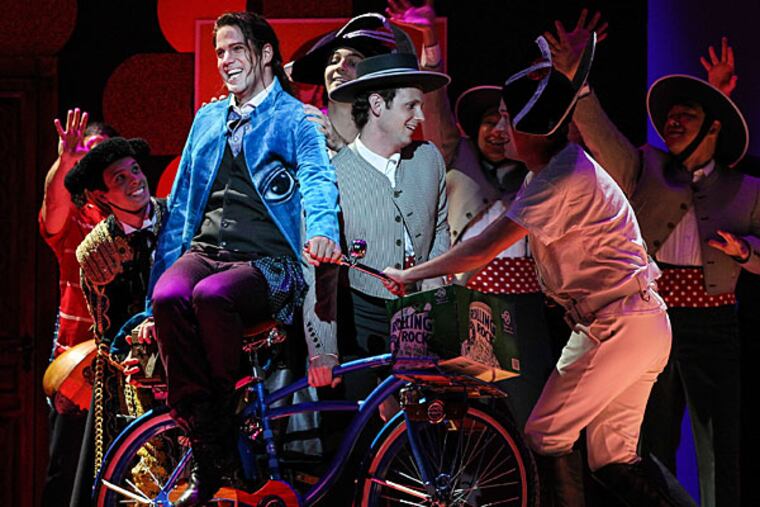'Barber of Seville' in a luscious setting
The Academy of Music stage all but bursts with inviting, primary colors, with shades of yellow and orange covering walls and floors. The village square's cotton-candy vendors have never been so bright. Police wear candy-colored uniforms.

The Academy of Music stage all but bursts with inviting, primary colors, with shades of yellow and orange covering walls and floors. The village square's cotton-candy vendors have never been so bright. Police wear candy-colored uniforms.
Was Opera Philadelphia's new Barber of Seville production one big lollipop for the eyes?
That would be selling the show short, with Rossini's music sounding fit and lively amid a cast of first-rate singers, even if, at Friday's opening, they weren't in first-rate form.
For all its evergreen popularity, The Barber of Seville often defies a convincing staging (Bartlett Sher's Metropolitan Opera production being a notable exception). Director Michael Shell and designer Shoko Kombara updated the classic story of a woman escaping a forced marriage to a deluded buffoon into the 1980s - post-Franco Spain with funhouse mirror warpage à la Pedro Almodóvar - with all the blissful senselessness that comes with it, aided by a particular stealth element.
In contrast to the less-exalted Opera Philadelphia opening nights that came with randomly wandering spotlights, this production has a true lighting design that added to the inviting warmth of the total package and accentuated all visual contours. Such attention to detail is especially appreciated in an opera whose libretto misses so many cues from the original Beaumarchais play that predominantly music-driven scenes may never work as modern theater. In effect, the production created an environment that simply made you want to be there.
Meanwhile, characterizations took considerable chances. The shifty music tutor Don Basilio became a delightfully bad aspiring Elvis, pulled off with fearless aplomb by Wayne Tigges. You won't see another Dr. Bartolo like Kevin Burdette's: He was a nerdy eye doctor who expressed his considerable disgruntlement with physical tantrums that lay somewhere between a seizure and the cha-cha. Rosina (Jennifer Holloway) was his assistant, while Jonathan Beyer was a well-dressed Figaro whose clothes had seen better days. Count Almaviva became a sexiest-man-alive celebrity - possible with a singer of Taylor Stayton's charisma.
But herein lay a castwide problem: So much theatrical multitasking in a production like this is going to take its toll somewhere, especially early in the run, and here it was the singing. Though Stayton made music out of his character's most broadly comic moments and is one of the few tenors around who can handle the Count's often-cut Act II aria (he maintains a mellow tone in the most ornate moments), even he was heard flagging and, generally, didn't command the music the way he might in subsequent performances. One could say "ditto" for nearly everyone else, except for Katrina Thurman's Berta (who made her often-cut aria pull its comic weight).
Coloratura could have been cleaner across the board, and perhaps conductor Corrado Rovaris, an authoritative Rossinian who drew a razor-sharp performance from the orchestra, could relax his tempos.
The Barber of Seville
Conducted by Corrado Rovaris, direction by Michael Shell, stage designs by Shoko Kambara, lighting by Driscoll Otto.
Wednesday, Friday, and Sunday at the Academy of Music, 240. S. Broad St. Tickets: $19-$249. Information: 215-893-1018, www.operaphila.org.